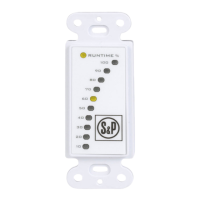TR90-Series Due to continuing product development, specications are subject to change without notice. © 2018 S&P
132104_002 Revised 9/2018 Page 8
Maintenance Requirements
The blower/motor package needs no lubrication:
Vacuum clean the blower wheels at the same time you clean the
face of the energy exchange core.
Purpose of an Energy Recovery Ventilation (ERV) System
Many modern homes are built air-tight for energy eciency and
comfort. The result is that natural air inltration rates are often
too low to provide acceptable indoor air quality. The solution
is to use an ERV to remove gaseous pollutants such as odors,
winter-time excess humidity, formaldehyde, smoke, radon,
vapors from cleaning products, and other chemicals. Removal of
dust and other small particles from your home is not the function
of an ERV.
When should you use your ERV?
Use the ERV when windows are closed and ventilation is needed.
When the outdoor air is warmer or cooler than comfortable, the
ERV allows a quieter, more secure home with the windows closed
and also saves energy.
Using an ERV with air-conditioning:
An ERV works very well with air-conditioning because its
“enthalpy-transfer” energy-exchange core reduces the amount
of moisture in the outside air that is brought in. ERVs are the
preferred way to ventilate while air-conditioning because it
brings in less moisture than any other ventilation method.
Controlling excess humidity during cold weather:
When the ERV is rst turned on at the beginning of the heating
season (or when rst installed), it will have to run full-time for
several days to reduce indoor humidity levels. A properly set
dehumidistat will do this automatically. If your control is the
proportional timer type (SPTL or SFM), it should be set to “100%”
for several days whenever you have a problem with excess
humidity during cold weather.
How much ventilation is right for you?
Always reference applicable codes and standards for ventilation
rate. Dierent households require dierent rates of ventilation,
depending on the pollutants found in each home. Most people use
one of two methods to control the operation of their ventilation
systems:
1. Provide a daily average of 0.35 Air changes per hour (ACH) for
your entire home. A proportional timer is the primary operating
control that allows you to reliably achieve this ventilation rate.
According to the American Society of Heating, Refrigeration and
Air-Conditioning Engineers (ASHRAE), this ventilation rate will
provide good air quality in most homes for most people.
At this rate, you will be changing the air in your home over
eight times per day. Most ERV systems are generally designed to
provide at least this ventilation rate.
Be sure to provide at least 15 CFM per person in the home. In
small homes this may mean more than nine air changes per day.
2. Ventilate enough in the winter to keep indoor humidity low.
Run the unit more to lower humidity.
In the winter, water vapor inside your home mostly comes from
people –breathing, showering, and cooking. When the outside air
is 40 degrees F or less, an ERV will reduce indoor humidity. This
helps to prevent condensation on windows.
High wintertime humidity generally means you need more
ventilation to control other indoor-air pollutants, like cooking
odors.
There is no known safe level of cigarette smoke.
Any ventilation system may provide noticeable
improvement in spaces where cigarettes are smoked,
but it cannot be expected to protect against the
severe long-term health hazards of exposure to
cigarette smoke.
Use your judgment:
These guidelines are a starting point. As long as the pollutants
you are concerned with are detectable (like water vapor or
odors) your nose can be a good guide, and you may nd that
fewer hours of operation will be sucient.
For households with smokers:
Smokers will need at least double the usual ventilation rate to
satisfy non-smokers in the same household.

